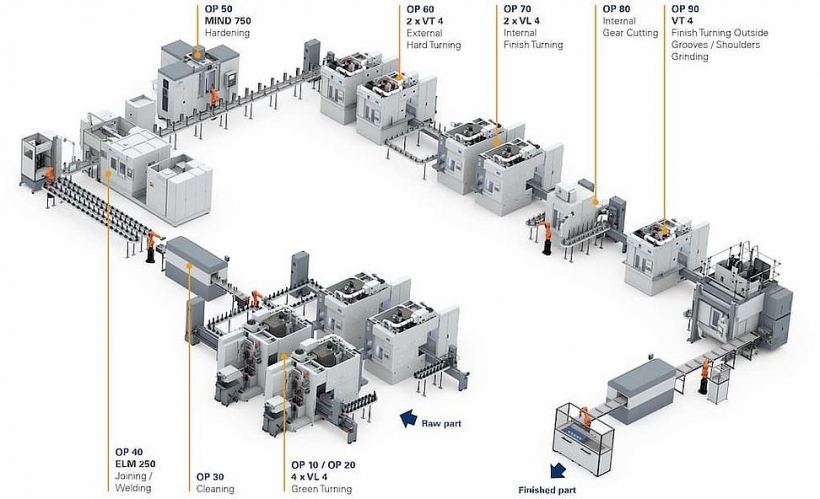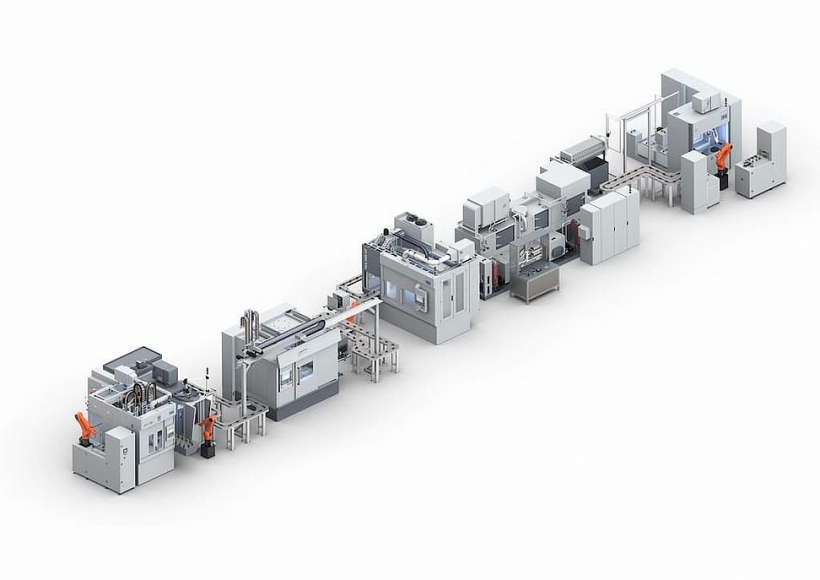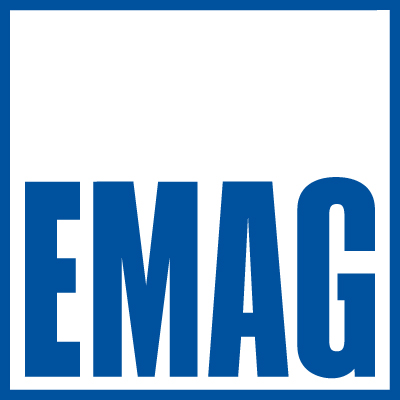The production of comprehensive manufacturing solutions from a single source is the main requirement for many mechanical engineering production planners. Typically, a general contractor would be responsible for the development of a complex line of interlinked machines with a variety of technologies. This provides the manufacturing company with two major benefits: the overall planning is easier (of the new factory) and a production partner that guarantees a perfectly designed, flexible, manufacturing solution, even for the most complex production situation. For years, the EMAG Group has been this partner, as it is one of the few machine builders that covers the entire process chain from soft to hard machining. Now, the experts are taking the next step with the creation of EMAG Systems and combining their project engineering expertise. The new company is the perfect partner for creating turnkey solutions, and is responsible for the overall project – combining the experience and knowledge of the various EMAG branches when necessary.

E-mobility: With increasing demands for product quantities, the focus is shifting to the establishment of comprehensive production systems. Example - rotor shaft: In the interlinked systems, soft machining, hardening and hard machining take place back to back and numerous technologies from turning, drilling and milling to inductive hardening and grinding are used.
For example, e-mobility: Here, the requirement for increased quantities is currently shifting the focus to the establishment of comprehensive production systems. Ultimately, this is the only way to be able to produce complex components such as rotor shafts or differentials in a process-consistent and cost efficient manner. In the interlinked systems, for example, soft machining, hardening and hard machining take place in direct succession and numerous technologies from turning, drilling and milling to induction hardening and grinding are used. "When designing a complex system like this, there are naturally many questions during the planning phase," explains Bernhard Böttigheimer, managing director of the new EMAG Systems. ”For example, users must understand the precise benefits and performance limits of the various tool processes, opportunities for the component assessed and a reliable process developed on this basis. To compile all of this information, the user must have access to a large amount of internal technological expertise. At EMAG, we have been working toward this for years – we have a variety of core processes within the Group, and are also developing in-house automation technology.”

Example - turbocharger shaft: The EMAG Group controls the entire process chain from soft to hard machining and therefore repeatedly acts as a general contractor.
Combined System Expertise
With all of these tools at their disposal, EMAG has been enjoying growing success in the production of turnkey manufacturing solutions in recent years. The mechanical engineering company even underwent an audit by a major OEM, in which all processes and structures relating to the development of large production systems were successfully examined. The specialists regularly provide proof of their system expertise outside the automotive industry, as demonstrated by various solutions for oil production technology manufacturers. In the past, experts within the individual EMAG companies performed the corresponding project management. Why is EMAG Systems now taking on this task globally?
"We are convinced that this business area is becoming increasingly important. The demand for complete production systems is growing because the range of products and parts is also increasing at many supplier companies and OEMs. This is putting more demand on production systems to be more flexible, and project engineering needs are being outsourced by many companies,” says Bernhard Böttigheimer.
And for these customers, EMAG Systems provides a central point of contact with experience in comprehensive turnkey production. These specialists, based in Salach, Germany, will examine each inquiry in detail, and then determine which technologies are needed for the project. With this information they will form a project team, consisting of engineers from different EMAG companies – this team will work together to form a completely customized solution for the project.
Although EMAG Systems may be new, our team is not! We have a variety of experts from within the company, who have been responsible for similar projects for EMAG in the past. With this team, customers will benefit from the experience and in-depth knowledge of all of the Group’s technologies. Within this new organization, the expertise of the employees will be combined, and the internal processes will be simplified. This allows those at EMAG Systems to focus on providing customers with a comprehensive process, while the individual EMAG companies focus on their specific technologies.

EMAG Systems – teamwork creates the perfect line solutions.
Initial Success Confirming the Path
Overall, the EMAG Systems experts see their market opportunities as very positive. After all, in the automotive industry, for example, many supplier companies must position themselves much more broadly and establish independent production solutions for a larger number of different drive technologies - from the classic "combustion engine" and hybrid solutions to completely electric. "In this industry, the demand for our resource planning expertise is growing quickly,” explains Böttigheimer. A second factor in the success of EMAG Systems is Industry 4.0. After all, Smart Factories that increase the productivity of a location, or improve process reliability are impossible without comprehensive, linked systems. This is where EMAG Systems and its project engineers play a critical role. A variety of current projects shows that this full scope approach is working in the market, especially in e-mobility. For example, EMAG is currently developing two production systems for machining a rotor shaft for European customers.
"We are clearly on the right track," sums up Böttigheimer. "With EMAG Systems, we intend to bring our long-standing project engineering expertise to the market in a selective manner, while continuing to grow over the next few years and at the same time pressing ahead with the technological development of production systems. We are in an ideal position for this."
Contact Details
Related Glossary Terms
- gang cutting ( milling)
gang cutting ( milling)
Machining with several cutters mounted on a single arbor, generally for simultaneous cutting.
- grinding
grinding
Machining operation in which material is removed from the workpiece by a powered abrasive wheel, stone, belt, paste, sheet, compound, slurry, etc. Takes various forms: surface grinding (creates flat and/or squared surfaces); cylindrical grinding (for external cylindrical and tapered shapes, fillets, undercuts, etc.); centerless grinding; chamfering; thread and form grinding; tool and cutter grinding; offhand grinding; lapping and polishing (grinding with extremely fine grits to create ultrasmooth surfaces); honing; and disc grinding.
- hardening
hardening
Process of increasing the surface hardness of a part. It is accomplished by heating a piece of steel to a temperature within or above its critical range and then cooling (or quenching) it rapidly. In any heat-treatment operation, the rate of heating is important. Heat flows from the exterior to the interior of steel at a definite rate. If the steel is heated too quickly, the outside becomes hotter than the inside and the desired uniform structure cannot be obtained. If a piece is irregular in shape, a slow heating rate is essential to prevent warping and cracking. The heavier the section, the longer the heating time must be to achieve uniform results. Even after the correct temperature has been reached, the piece should be held at the temperature for a sufficient period of time to permit its thickest section to attain a uniform temperature. See workhardening.
- induction hardening
induction hardening
Surface-hardening process in which only the surface layer of a suitable ferrous workpiece is heated by electromagnetic induction to above the upper critical temperature and immediately quenched.
- milling
milling
Machining operation in which metal or other material is removed by applying power to a rotating cutter. In vertical milling, the cutting tool is mounted vertically on the spindle. In horizontal milling, the cutting tool is mounted horizontally, either directly on the spindle or on an arbor. Horizontal milling is further broken down into conventional milling, where the cutter rotates opposite the direction of feed, or “up” into the workpiece; and climb milling, where the cutter rotates in the direction of feed, or “down” into the workpiece. Milling operations include plane or surface milling, endmilling, facemilling, angle milling, form milling and profiling.
- turning
turning
Workpiece is held in a chuck, mounted on a face plate or secured between centers and rotated while a cutting tool, normally a single-point tool, is fed into it along its periphery or across its end or face. Takes the form of straight turning (cutting along the periphery of the workpiece); taper turning (creating a taper); step turning (turning different-size diameters on the same work); chamfering (beveling an edge or shoulder); facing (cutting on an end); turning threads (usually external but can be internal); roughing (high-volume metal removal); and finishing (final light cuts). Performed on lathes, turning centers, chucking machines, automatic screw machines and similar machines.

